Contributory members are able to log private notes and comments about each site
Sites Anne T has logged. View this log as a table or view the most recent logs from everyone
North Haystack Hill
Trip No.34 Entry No.2 Date Added: 21st Jul 2017
Site Type: Ancient Village or Settlement
Country: England (Northumberland)
Visited: Yes on 18th Jul 2017. My rating: Condition 2 Ambience 4 Access 3

North Haystack Hill submitted by Anne T on 21st Jul 2017. Stepping over the medieval bank and walking some 30 metres into the enclosure, this circular bank came into view.
(View photo, vote or add a comment)
Log Text: North Haystack Hill, Ingram, Northumberland: After Ingram Hill Enclosure, we took the permissive footpath to its east, walking up between Turf Knowe to our east and Wether Hill to the west. From this point on, for the next quarter of a mile, we seemed to be constantly moving out of the way of a tractor and a small four-wheel drive van and trailer mowing bracken (they seemed to target us with every turn!), up until the division of footpaths just before this earthwork, which appeared as a low stone and earth mound, about 1 metre wide and 80cm high, running to the left of the footpath. It ran for several hundred metres with the occasional bank peeping out of the bracken to the east. By this time, we were 800 metres from Ingram Hill Settlement, and a couple of hundred yards from the main Haystack Hill complex. We stepped over the low electric wire that was keeping the sheep in a particular area and went to investigate.
What a view to have from your front door, down the Middledean Burn valley to the west and the Breamish Valley and Ingram below.
Getting back home and opening up Pastcape, I was surprised to find this is a recorded Iron Age/Roman enclosed settlement. Although the long bank is medieval, the settlement is described as ‘much mutilated’ with a number of scooped hut circles. It can be seen on UK Grid Reference Finder aerial images, with ridge and furrow ploughing cutting over the top.
Making our way back to the path, which by now was levelling off, we continued up the slope towards the larger Haystack Hill settlement.
Haystack Hill (Ingram)
Trip No.34 Entry No.3 Date Added: 21st Jul 2017
Site Type: Ancient Village or Settlement
Country: England (Northumberland)
Visited: Yes on 18th Jul 2017. My rating: Condition 2 Ambience 4 Access 3
Haystack Hill (Ingram) submitted by SolarMegalith on 16th Mar 2013. Remains of a stone wall - view from the NE (photo taken on March 2013).
(View photo, vote or add a comment)
Log Text: Haystack Hill Settlement Complex, Ingram, Northumberland: Having stopped off at North Haystack Hill, it was getting hot by this point, although there was a pleasant breeze. The path was levelling out now and there was an electric fence to our left hand side. Where this had dropped down to the grass at one point, we made our way across to the gate at the north western part of the field. The ground here was very boggy, descending into deep puddles at various points, so we picked our way around. A sign on the gate said ‘end of access land’ although there is a permissive footpath around the edge of the field leading into the south western corner of this complex settlement.
This site is huge. I wish I’d printed off an aerial photograph to take with me, so I could have understood it better – a good excuse for a return visit.
We first explored the rectangular enclosure with its row of hut circles in, then made our way between the B2 (the southern most of the two B enclosures) and C.
Wow. Although deep in bracken, it was still possible to make out tall banks and circular features I felt very priviledged to have come here, as I did at Burdhope last week. A brilliant, brilliant site. With the other hillforts all around, it was very atmospheric.
Beanley Moor Enclosure
Trip No.34 Entry No.4 Date Added: 22nd Jul 2017
Site Type: Ancient Village or Settlement
Country: England (Northumberland)
Visited: Yes on 18th Jul 2017. My rating: Condition 1 Ambience 2 Access 4

Beanley Moor Enclosure submitted by Anne T on 22nd Jul 2017. The robbed out rampart can be seen as a shallow double ditch in the south west of the enclosure. This location has lovely views down to the River Breamish valley.
(View photo, vote or add a comment)
Log Text: Beanley Moor Iron Age Defended Settlement, Northumberland: We had an abortive attempt to find the Fawdon Cross Base at NU 0281 1591 (nowhere anywhere nearby to park) and Beanley Plantation Hillfort. The tracks to the latter were either waterlogged (husband said we needed diving equipment – a slight exaggeration, I think!), although we could have tried from the paths through the forest from the south (but didn’t). We then made our way to the Beanley Moor settlement/enclosure just to its north. This is a short hop up the field. There is a path leading up the slope (it’s all access land here) which brings you to the southern edge of the enclosure, although having spotted a slight bank popping up out of the grass, we made a more direct bee-line up the slope.
Curious how the landscape has changed in just a few miles. The area is completely sandy – like a beach, which it must have been at one point in the dim and distant path, although higher up the slope it becomes more of a loam.
Very, very little remains of this possible Iron Age settlement, although there was enough left of two parallel shallow ditches for us to follow their line round in a circle. Thought we spotted a possible entrance in the south west of the enclosure, a possible roundhouse partly built into the bank (although heavily disguised by tussocks and bracken in parts) and a hollow way leading north-west/south-east along the north eastern edge of the settlement, leading up to the Beanley Plantation Hillfort.
Brilliant views down to the River Breamish Valley, but that’s as much as can be said for this site. Glad we stopped off, though.
Barntalloch (Langholm)
Trip No.35 Entry No.1 Date Added: 27th Jul 2017
Site Type: Misc. Earthwork
Country: Scotland (Scottish Borders)
Visited: Yes on 24th Jul 2017. My rating: Condition 2 Ambience 3 Access 5
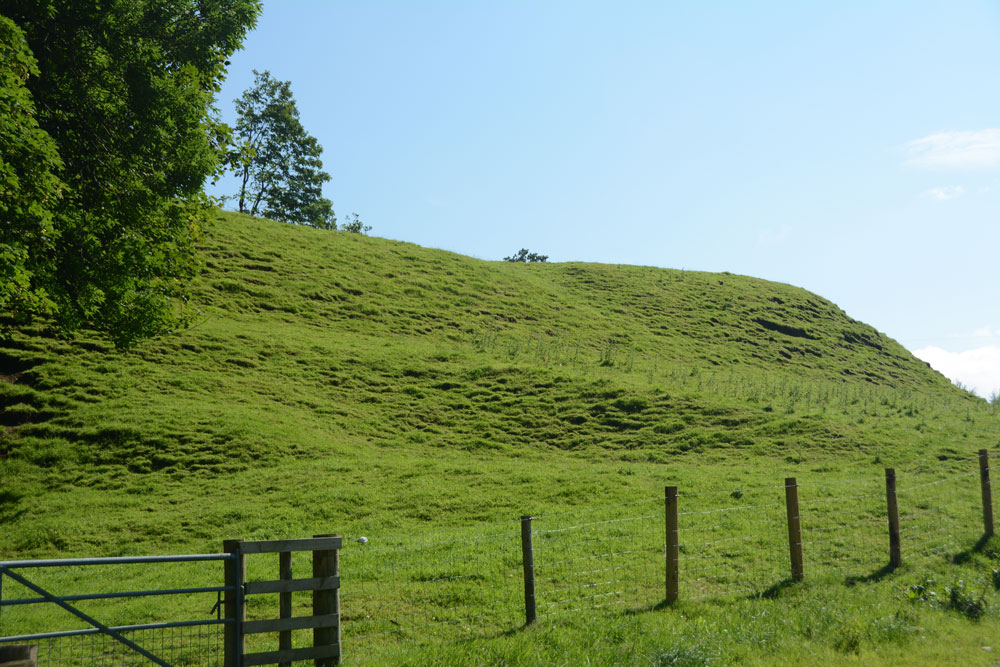
Barntalloch (Langholm) submitted by Anne T on 27th Jul 2017. First view of the motte as we took the south westerly track through the farmyard.
(View photo, vote or add a comment)
Log Text: Barntalloch Motte, Staplegordon, Langholm: It was dull and very wet at our house, and fed up of the rain, we decided to head off to the Scottish Borders for some sunny, 25 deg C weather. Landing in Langholm by 2.30pm, we stopped off for coffee and cake before heading off into the wilds of Eskdale.
I spotted this site on the map, just west of Langholm, down a small road leading to a hamlet called Staplegordon. It caught my eye because it not only had the motte but the remains of a chapel. I like looking around the gravestones.
We parked in what looked like a parking area for fishermen to the right of the far side of the bridge. There is actually another car park by the farm nearer to the motte. There are posts indicating the routes of different Langholm Walks.
Just past the farm to the left of the bridge, the track splits at NY 35445 87796. The northern section leads down to the old graveyard and a bungalow (looks like the chapel was converted into a dwelling). A track led through another farmyard to our left which curls to the south west, around the side of the motte.
The lady farmer roared up on her quad bike and stopped to say hello. She didn’t seem to mind us tramping through her farmyard, but wasn’t very forthcoming. When I got home and did some research on Canmore, I found out that the old chapel was supposed to have an inscribed stone. We didn’t walk down there as we couldn’t see a way of reaching the churchyard except through the main gate of the cottage.
Little Hill (Craig)
Trip No.35 Entry No.2 Date Added: 26th Jul 2017
Site Type: Hillfort
Country: Scotland (Scottish Borders)
Visited: Yes on 24th Jul 2017. My rating: Condition 2 Ambience 4 Access 4

Little Hill (Craig) submitted by Anne T on 26th Jul 2017. Standing in the middle of the entrance to the northern side of the hillfort looking more or less north over the Esk Valley below. There is an old hollow way which curves down to the modern road below.
(View photo, vote or add a comment)
Log Text: Little Hill Hillfort, Craig, Scottish Borders: This might be a 'short walk on a footpath', but it was a steady climb! After visiting Barntalloch Castle, we could see no way of getting into the old churchyard nearby, as it looked as if the building had been converted into a house. Mistake not to try, as Canmore said there was an inscribed stone.
We drove onto Little Hill, stopping to take a photograph of Barntalloch from a layby on the B709. The River Esk looks glorious sparkling in the sunshine with its loops and cobble banks.
There is a footpath/track leading up to Little Hill hillfort from just before the bend at Craig at NY 33656 88271, where there was room to tuck the car in at its junction with the road. There has been lots of activity with telegraph poles in this area, with lots of spare ones lying around; in fact climbing up the hill they got in the way of the view over to the west until we got above them. Craig Hill to the south of Little Hill looms large and dominates the scenery; there is also a settlement on its lower slopes south of Little Hill, although we didn’t spot this on the climb up.
We left the stony track up the hill and followed what seemed to be a hollow way up to the fort, approaching this from its north western side where I spotted the well at NY 33858 88237, next to a cattle feeder.
This is a lovely spot with its flower meadows and virtually 360 degree views. There don’t seem to be any features in the interior, or at least we didn’t see them as the grass was so lush. Andrew thought he saw a couple of roundhouses, due to the change in vegetation, but I thought it was a bit of a stretch, but there were two circular areas that were slightly scooped and had less wild flowers within them.
I walked down to the south western (stem end of the pear) end of the fort, which is slightly separated from the rest of the fort by a dip, effectively splitting the fort in two.
On the way back down we stopped to photograph the entrance at the northern end of the fort. From here we could see the racing tracks of the race horse training stables in the valley below. There was also a line of stones running from approx.. NY 33920 88223 to NY 33978 88200 near the road also seems to follow the line of a water course. If you plot the points of the well and these stones, they seem to follow a straight line. Some of the taller stones also hide springs.
A lovely walk and well worth stopping. The views on a sunny, warm day like today were lovely. As I keep repeating, our ancestors chose some very nice places to live.
Newhall Hill (Paddockhole)
Trip No.35 Entry No.3 Date Added: 26th Jul 2017
Site Type: Ancient Village or Settlement
Country: Scotland (Scottish Borders)
Visited: Yes on 24th Jul 2017. My rating: Condition 2 Ambience 4 Access 3

Newhall Hill (Paddockhole) submitted by Anne T on 26th Jul 2017. First glimpse of Settlement B which is the lower of the two settlements on Newhall Hill. There is a massive earthen bank with a deep outer ditch. The curving banks make it look round, but it is fact rectangular with rounded edges. This photo looks over the entrance in the south east.
(View photo, vote or add a comment)
Log Text: Newhall Hill Settlements, near Paddockhill, Scottish Borders: From Little Hill, we thought we’d stop off at Balliehill Hillfort again, but driving up to it, it was covered in enormous cattle grazing contentedly within it. Taking one look, we decided to press onto Newhall Farm. Following the minor road that runs alongside the western bank of the Water of Milk, we enjoyed the views down the valley. Reaching Paddockhill, we turned right, then immediately right again, over Paddockhill Bridge and followed the road through Newhall Farm to a small bridge hidden between the trees. We couldn’t see the burn as it was being used as a dump for old industrial pipes and equipment, fencing and telegraph poles, but just before the bridge was a small area which had been hard-cored, so we parked there. The gate to the two tracks leading up Newhall Hill was just behind us. Taking the right hand track, we plodded up this steeper-than-it-looked hill. Would it never end??
Eventually the track ran out and we set off across the pasture to find the settlements. I heard the noise of a quad bike and the farmer appeared, with this two dogs, over the top of a hill, screeching to a halt in front of me. I thought he was going to hit me, so took a large backwards step, but he stopped in time. “Nearer to heaven here’ he said and pointed to all the wind farms surrounded the hill. “Don’t think they do any harm, do they?” he added. I put my hand out to stroke one of the dogs and the farmer barked at me: “Don’t! He’ll have your hand off.” He told us the settlements were just over the next small brow on the hill, said he lived at the small farm yonder rather than the big one down in the valley below that we could see, then hared off at great speed with both dogs balancing on the back of the quad bike.
Two hundred yards further on, a deep ditch and large bank of Settlement B came into view, complete with eyesore of a very large quarry beyond.
I walked all round the outer bank of the lower settlement, then went into the inside. Apart from a very boggy part, which looked like it might have been a well at some point, we couldn’t make out any features internally.
I would have liked to have walked up the hill to Settlement A but the heads and bodies of some very lively bullocks kept watching us. I didn’t fancy being surrounded by them, so we decided to walk back down to the car.
We would have ended up at the Severn Brethren stone circle, but as we neared it, realised we’d been here before, and it was very unremarkable.
Green Castle Ringwork
Trip No.36 Entry No.1 Date Added: 31st Jul 2017
Site Type: Misc. Earthwork
Country: England (Northumberland)
Visited: Yes on 30th Jul 2017. My rating: Condition 2 Ambience 3 Access 5
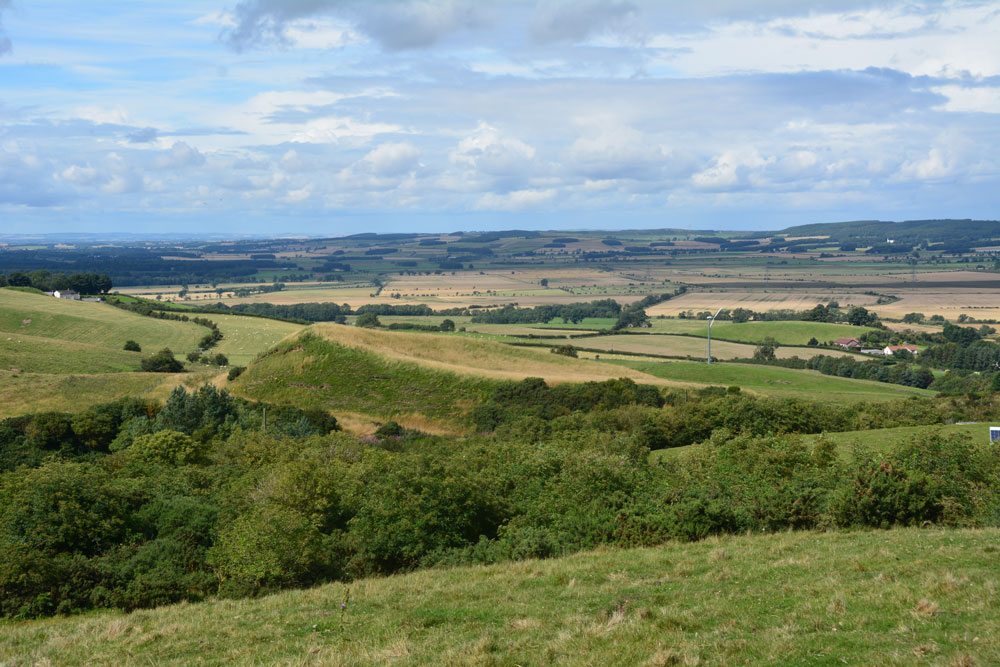
Green Castle Ringwork submitted by Anne T on 31st Jul 2017. Climbing (sorry, walking!) up the track from the small parking area near the cattle grid to Wooler Common, we got a good view of the mound from the top. It looks distinctly saucer shape, hence the Cup and Saucer name.
(View photo, vote or add a comment)
Log Text: Green Castle Ringwork, Wooler: After having stopped off at the ‘usual café’ in Wooler for refreshments, we headed off towards Wooler Common, from the High Street taking Ramsey Lane which becomes Common Road.
At NT 98195 27735 there is a small parking area, where a footpath leads south westerly up and over the Common. From here, the Ringwork looks like part of a giant rubbish tip, with its south and western sides protruding up over the hedgerow like a giant green triangle. Given that to it’s south east there is a huge area for storing skips, it looks at first sight as if the mound is used for a rubbish dump, but it’s not.
There is no access into the field the ringwork sits in (gates are padlocked, and the only gate that opened (immediately opposite the parking area) led down to a wooded area and small ravine.
We actually got a good view of what looks like a ‘Refresher’ sweet by walking up the path towards The Kettles. From here, even the stones in the south western side, where the mound has been eroded, are visible, together with a short section of ditch.
I didn’t spot the telephone wire snaking across the photograph until I loaded it onto my computer.
The Kettles (Wooler)
Trip No.36 Entry No.2 Date Added: 31st Jul 2017
Site Type: Hillfort
Country: England (Northumberland)
Visited: Yes on 30th Jul 2017. My rating: Condition 3 Ambience 5 Access 4
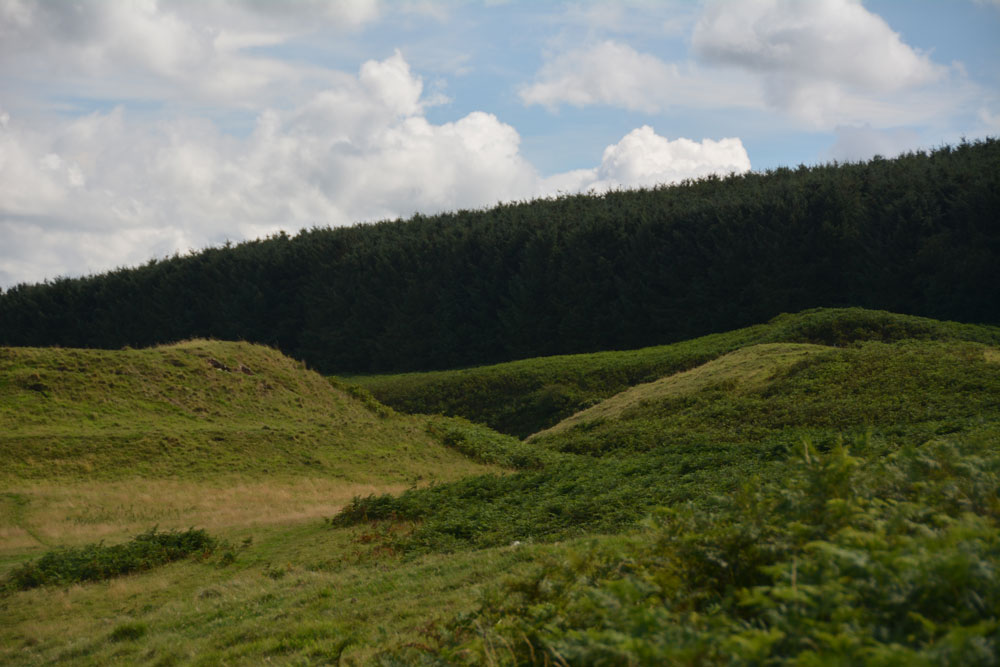
The Kettles (Wooler) submitted by Anne T on 31st Jul 2017. Getting closer to the rampart and ditch on the north western edge of the hillfort. The banks stand really tall, with steep sides, with an earth and stone construction.
(View photo, vote or add a comment)
Log Text: The Kettles Hillfort, Wooler: From Green Castle, we continued along the track leading first south west up the small hill, then turns south east along the top of the promontory. Our GPS told me there was just over 511 metres to walk from the small parking area to the grid reference given by Pastscape, but it seemed a lot less than this.
The paths are well kept, as on the Breamish Valley trails, with low, mown grass which is soft underfoot and easy to walk. As we walked along the promontory, the northern section of ramparts came into view. As we got closer, it became obvious how large these were.
Paths lead up into round the exterior edges of the hillfort. There are bracken and scree covered valleys on either side. The first thing we came across were some strange concrete blocks and what looked like the tiled remains of an old toilet at approx. NT 98398 27352, but then there are the recorded remains of pillboxes in this area, so must have been used for military training during the last war.
As we walked along, we crossed three distinct banks which had been cut by the paths, which are the three ramparts (in places four) that cut the fort into two. Walking past the fourth rampart, it felt as it had on Little Hill in the Scottish Borders, as if I was on the prow of a ship looking down across the land below. Crossing to the eastern side of the fort, at this point, we were almost directly above Maiden Well and the King’s Chair. To reach these, we would have need climbing equipment to abseil down, so we walked back to the car and drove round to the path leading to The Pin Well.
Looking at the aerial images on UK Grid Reference Finder, the outline of the fort is clearly visible.
Maiden Well (Kettle Hill)
Trip No.36 Entry No.3 Date Added: 31st Jul 2017
Site Type: Holy Well or Sacred Spring
Country: England (Northumberland)
Visited: Yes on 30th Jul 2017. My rating: Condition 3 Ambience 5 Access 4
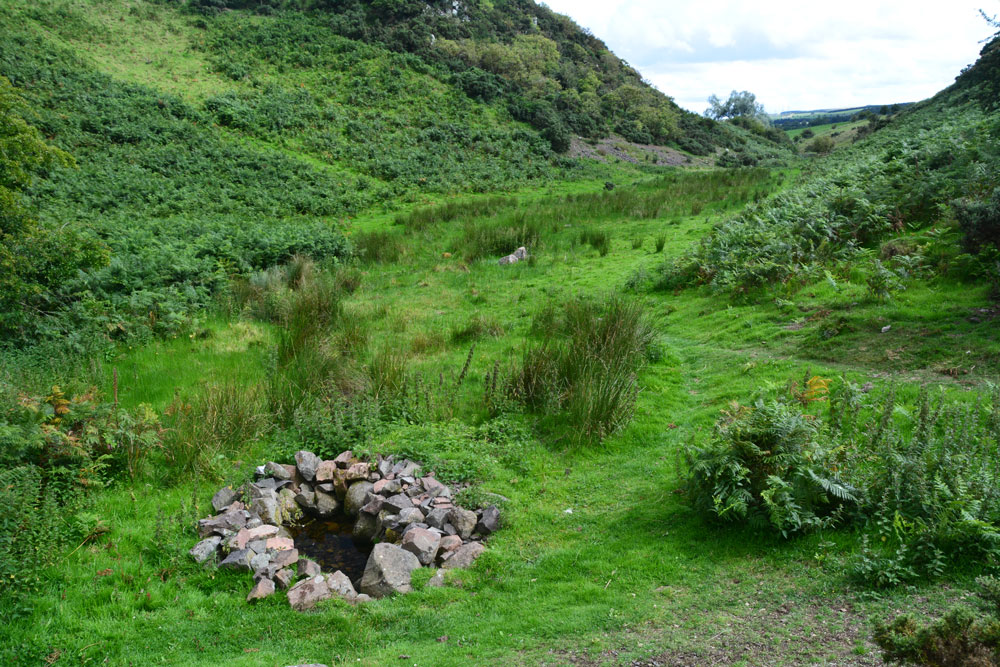
Maiden Well (Kettle Hill) submitted by Anne T on 31st Jul 2017. Standing just north of the well, looking back towards the quarry. The small stream which runs from the well is defined by small groups of stones placed along each side of the water course, together with a lush growth of bracken in the wetter parts of the ground. It's a very enigmatic spot, especially with The Kettles Hillfort rising up above you (to the right, out of sight, in this image).
(View photo, vote or add a comment)
Log Text: Maiden Well and The King's Chair, Wooler: After having walked round the outer perimeter of the promontory of The Kettles, we’d actually stood just above the site of the Maiden Well (Pin Well), but would have needed a rope and harness to descend the vertical cliff down to it. We walked back to the car, drove back into Wooler, then back out again on the road to the tiny (and ancient) hamlet of Earle.
Where the road splits at NT 99100 26973, we took the western fork (right hand if coming from Wooler) and take the track that runs from NT 98924 26750 to a small quarry. Note: the gate to this road is kept padlocked to prevent people taking vehicles up to the quarry, but there are gates for walkers. Husband Andrew hadn’t spotted the gate, so we ended up climbing the fence into the neighbouring field, then back out again!
Just before the main entrance to the quarry a small (overgrown) footpath leads to your left from NT 98808 26845. We followed this for some 300 metres, the nettles eventually giving way to open ground in a small valley/ravine. We first spotted the King's Chair protruding from the hill in front of you, although I was a bit dubious at first as the stone was hidden by lush, tall bracken growing round it from the rock face. Walking further forward the well is hidden under a hawthorn tree.
The well is in a lovely, enigmatic location. It looks as if someone has recently created this lovely circular ‘halo’ of stone around the clear water. A stone a metre of so to it’s north west has a hole at its base. Glimpsing down, I could see the water running into the well pool.
A small stream runs out of the well pool. The water course is marked by groups of stones leading back towards the entrance to the quarry, on either side of the small stream, which is also marked by lush grass and bracken growing on either side of it. I walked up a little way to look at various groups of stones, to find parts of the ground boggy and heavy with water.
With The Kettles rising up above you to the east, this is a really nice spot. I could have lingered longer, but 4-5 Romano-British settlements called. Time to move on.
Carey Burn (Harthope Valley)
Trip No.36 Entry No.4 Date Added: 31st Jul 2017
Site Type: Ancient Village or Settlement
Country: England (Northumberland)
Visited: Yes on 30th Jul 2017. My rating: Condition 1 Ambience 2 Access 4

Carey Burn (Harthope Valley) submitted by Anne T on 31st Jul 2017. Looking westwards up Snear Hill to the second scooped settlement, which wasn't marked on the OS map. The western bank of this settlement can be seen running across the middle of the photograph, left to right.
(View photo, vote or add a comment)
Log Text: Carey Burn Votadinian settlement, Harthope Valley: After the beautiful Maiden/Pin Well, I got stuck on a 'precipice' above the Coldgate Burn trying to get to the Romano-British settlements to the west of North Middleton and bottled out (my dreaded fear of falling - I've subsequently found the map showed a low level, apparently straightforward footpath from North Middleton, although it was about a mile either way). After this experience, I need to try and regain my composure.
On the map, just across the road from the footpath we’d tried, and just west of Carey Burn Bridge, a track ran up the hill at NT 97513 24937, just above a currently empty barn. A settlement was shown here. An NNPA footpath ran up the hill, so we opened the gate and followed the path up.
We did find the settlement, but it looked as if a fence had recently been installed along the north western bank, crossing over part of it to the eastern side.
A long, low earth and stone bank about 1 metre tall and 2 metres wide ran parallel to the fence from NT 97353 24907 to NT 97301 24938 then curves around to the Carey Burn at NT 97337 25012. This bank can be seen on UK Grid Reference Finder.
On getting home, I discovered from Pastscape that the settlement we looked at was classed as Votadinian. There is a second settlement, which isn’t marked on the map at NT 97132488, which is further up the hill.
Venchen Farm Cottages (Town Yetholm)
Trip No.37 Entry No.1 Date Added: 7th Aug 2017
Site Type: Standing Stone (Menhir)
Country: Scotland (Scottish Borders)
Visited: Yes on 6th Aug 2017. My rating: Condition 3 Ambience 3 Access 5

Venchen Farm Cottages (Town Yetholm) submitted by Anne T on 7th Aug 2017. The Venchen Farm Cottages stone, looking south east towards Town Yetholm, over the Bowmont Water Valley. It wasn't raining (much!) when I took this photograph - that's just 'Scotch Mist' in the background.
(View photo, vote or add a comment)
Log Text: Venchen Farm Cottages Standing Stone, Scottish Borders: Having left home to avoid days of damp, rainy weather, we went in search of sunshine and blue skies. The further we travelled up the A68, the more obvious it became that the grey skies got darker the more northerly we got. As we reached Town Yetholm, the heavy raindrops started to fall with the ferocity of hail.
Venchen Farm Cottages are easy enough to find, heading north about 1.6 km north out of the village. This stone looms large out of the grassy verge; at first I thought it was just a village sign. We pulled into a small parking spot just past the stone, nearer to the cottages, by which time it was pelting down even harder and I had the camera covered with kitchen towel and handkerchiefs to keep it dry.
The Canmore notes, which we’d printed off before setting off, said that a hedge had been removed for the stone to be exposed. On UK Grid Reference Finder, the hedge can be seen with the stone tucked away behind it. The grass verge itself didn’t seem to show any signs of disturbance, considering the hedge was only removed in February this year, although the earth around the stone was visible, together with some packing stones and the vegetation along the verge was more weeds than grass.
Difficult to get photographs with the rain, but managed to keep wiping the lens.
Virtue Well (Yetholm)
Trip No.37 Entry No.2 Date Added: 7th Aug 2017
Site Type: Holy Well or Sacred Spring
Country: Scotland (Scottish Borders)
Visited: Yes on 6th Aug 2017. My rating: Condition 2 Ambience 2 Access 4
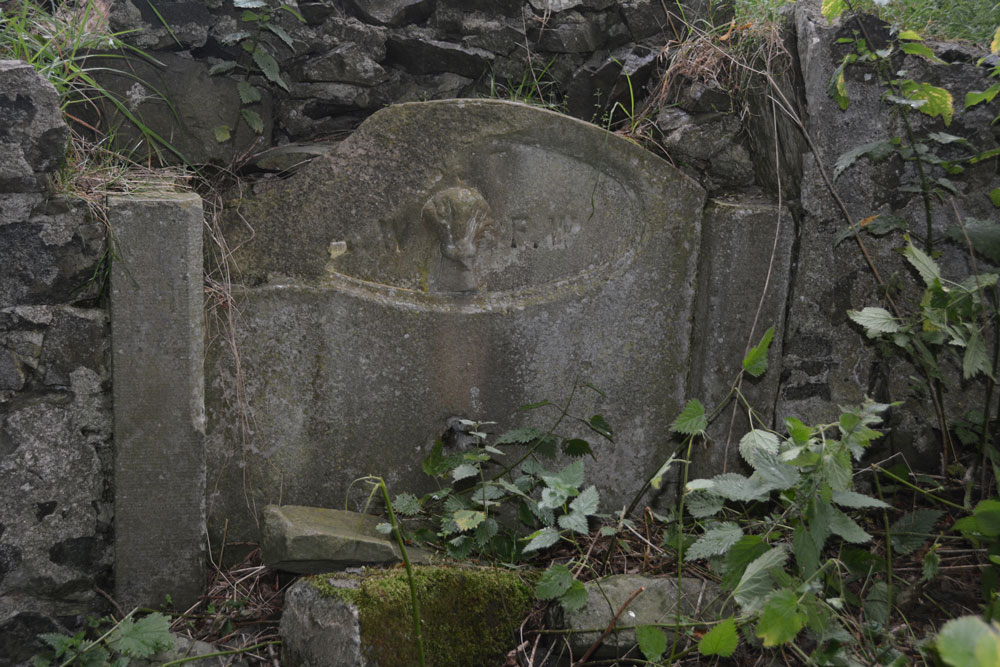
Virtue Well (Yetholm) submitted by Anne T on 7th Aug 2017. Close up of the central panel, showing the basin broken and lying at its base amongst a tumble of stones from the retaining wall.
(View photo, vote or add a comment)
Log Text: Virtue Well, Yetholm: From Venchen Farm Cottages Standing Stone, by the time we drove back down to the west side of the road bridge over Bowmont Water at NT 82132 28576, and parked at a little layby just before the road junction, the rain had eased off a little.
There were two routes up to the well, the first at NT 82128 28603 led up a wet, slippery hill towards a wood, which was rather overgrown. We opted for the footpath proper, starting at NT 82206 28645, with a proper track leading up to Braehouse Farm.
According to UK Grid Reference Finder, the path deviates through the woodland, past the well, but in real life, the track continues straight up to the farm, and we had to tramp through knee high grass through the wood.
Having found this poor little well, I couldn’t but help feel sorry for it. Such a tragedy. It reminded me of the well we’d seen in Middleham – broken up, dry and just part of an old garden wall. At least under the trees we were largely sheltered from the rain.
Sheilknowe Burn Enclosure
Trip No.37 Entry No.3 Date Added: 8th Aug 2017
Site Type: Ancient Village or Settlement
Country: Scotland (Scottish Borders)
Visited: Yes on 6th Aug 2017. My rating: Condition 1 Ambience 3 Access 4
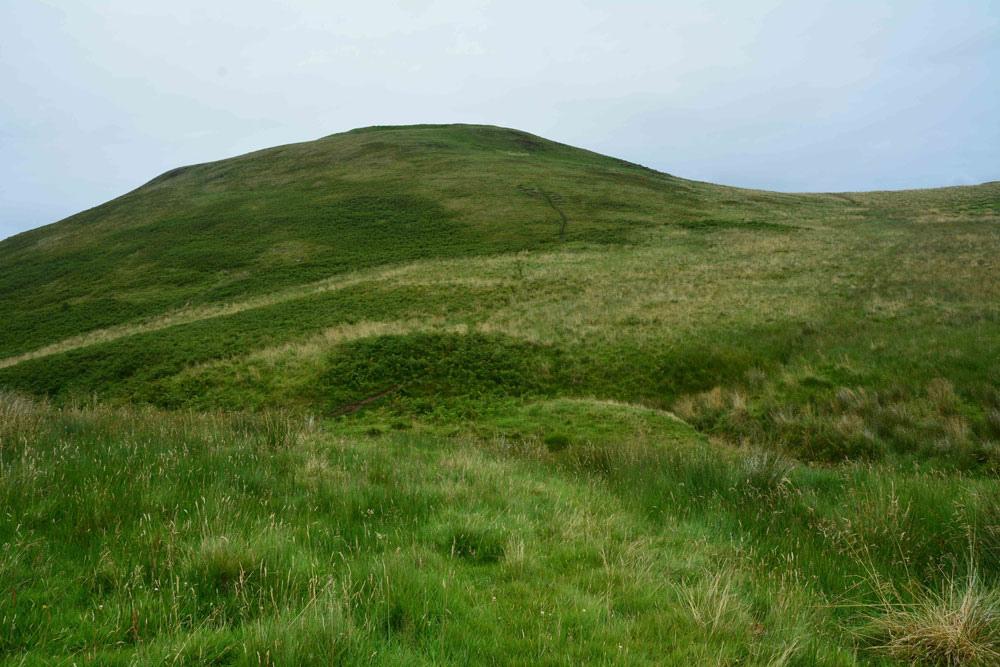
Shielknowe Burn Enclosure submitted by Anne T on 8th Aug 2017. Standing near the fence which cuts across the southern boundary of this horseshoe shaped enclosure, looking towards Shielknowe Burn, part of the land in a small loop of the burn seems to have slipped down. The burn forms the northern most boundary of the settlement. Green Humbleton hillfort is almost in the centre/top of the photograph.
(View photo, vote or add a comment)
Log Text: Shielknowe Enclosure, Yetholm: From the Virtue Well we made our way to Kirk Yetholm, finding the small side road which is actually the Pennine Way, but which can be driven down to a small parking area beside where the Halter Burn and Shielknowe Burn meet. Here a footbridge leads over the Burn, the Pennine Way and St. Cuthbert’s Way meeting at this point.
We tried St. Cuthbert’s Way first of all, running parallel to Shielknowe Burn on it’s eastern side, but after a few hundred yards, came across a rocky outcrop where I would have needed to turn into a mountain goat (OK for my husband, but not for me) so we retreated and walked almost back to the footbridge. There is another mown track which runs on the western side of the stream – boggier but much easier to follow and the sides of the small gorge not quite so precipitous.
It's a good job we had the GPS with us, together with a printed sheet of the Canmore details, otherwise we’d have walked across this settlement without knowing it was there. By finding it’s centre (the south western edge is almost at the corner of the fenced off field containing Shielknowe Burn Scooped Enclosure.
By carefully walking over the area, we could see very slight banks and changes in vegetation, but my goodness, had we not been out with NOWTAG, we would have missed this.
Shielknowe Burn Scooped Settlement
Trip No.37 Entry No.4 Date Added: 8th Aug 2017
Site Type: Ancient Village or Settlement
Country: Scotland (Scottish Borders)
Visited: Yes on 6th Aug 2017. My rating: Condition 2 Ambience 3 Access 4
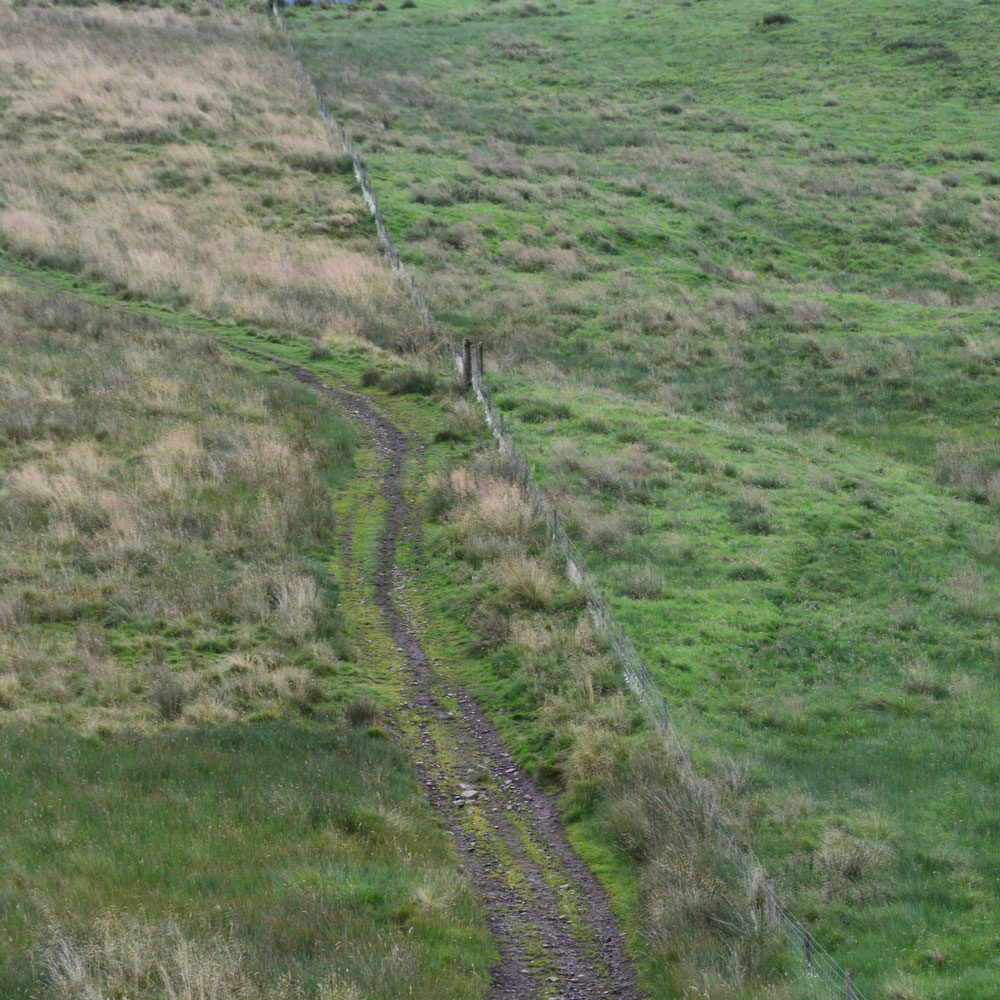
Shielknowe Burn Scooped Settlement submitted by Anne T on 8th Aug 2017. This Scooped Settlement can be seen from Shielknowe Enclosure. Its western most building platform is cut by a modern fence and St. Cuthbert's Way. Photograph taken from the almost ruined Shielknowe Enclosure to the south of Shielknowe Burn.
(View photo, vote or add a comment)
Log Text: Shielknowe Burn Scooped Settlement, Yetholm: This scooped settlement, lying on the northern side of Shielknowe Burn is much easier to see, and is visible from Shielknowe Enclosure, cut by the fence which also cuts the Enclosure. The muddy track from Shielknowe Enclosure runs downhill, crosses the burn, and leads up to join St. Cuthbert’s Way.
Two scooped out areas can be seen, although the farmer had very tightly knotted the twine securing the gate, so whilst Andrew (husband) hopped over the gate, I undid the ‘Gordion Knot’ to get into the settlement. The grass was very tussocky and wet, so walking along the banks of the western most scoop was interesting.
Much more exciting sites to come, so we didn’t spend an awful long time here.
Green Humbleton Settlement
Trip No.37 Entry No.5 Date Added: 8th Aug 2017
Site Type: Ancient Village or Settlement
Country: Scotland (Scottish Borders)
Visited: Yes on 6th Aug 2017. My rating: Condition 2 Ambience 4 Access 3

Green Humbleton Settlement submitted by Anne T on 8th Aug 2017. The western half of the scoop. Green Humbleton Hill can be seen just starting to rise up on the middle/upper right hand side of the image. The hillfort certainly dominated the western view.
(View photo, vote or add a comment)
Log Text: Green Humbleton Scooped Settlement, Yetholm: Now this was a settlement I could get excited about, and what views! If the first two enclosures on the way up here were somewhat dull, this more than made up for it! To the north and east the land dropped steeply away to Humbleton Syke and to the west Green Humbleton hillfort dominated the view.
By the time we got here, the wind was absolutely howling and we had to retreat to the walls of the scoop to get some respite.
There is a very clear oval scoop with a D-shaped enclosure to its north. To the north east of the D-shape there were some stones that Andrew called me over to look at. I did want to be persuaded they formed a cist. What a place to be buried. It could be a well, but there is no mention of either in the Canmore records.
If it hadn’t been so windy, I would have loved to have spent more time here. With the dark clouds looming, we decided to go up to the Stob Stones rather than risk being blown off the top of Green Humbleton hillfort. If the weather was favourable, we’d try on our way back.
Stob Stones
Trip No.37 Entry No.6 Date Added: 8th Aug 2017
Site Type: Standing Stones
Country: Scotland (Scottish Borders)
Visited: Yes on 6th Aug 2017. My rating: Condition 3 Ambience 4 Access 3

Stob Stones submitted by Anne T on 7th Aug 2017. Whilst the rain lessened for a moment, the hills at the western side of the Bowmont Water Valley came briefly into view!
(View photo, vote or add a comment)
Log Text: Stob Stones, Scottish Borders: From the Green Humbleton Scooped Settlement, by the time we started climbing up towards the Stob Stones, not only was the wind was howling and I was leaning hard into it, but the rain drops were like small pins being driven into my cheeks. I confess to getting a bit fed up and wanting to turn around at this point, but a long-held desire to see these stones kept me going. It was worth it.
Walking over the Stob Rig earthworks (I stopped to photograph these on the way down), the Stob Stones are two standing stones, one now broken and lying prone, sitting on a sort of promontory as the ground to the north and west drops steeply down. Canmore says these stones are at over 1,000 ft above sea level and are situated 230 yards west of the Border. They definitely sit on some kind of mound.
To the west lies the border between England and Scotland, and we walked a 100 metres or so further up the hill, just so we could see the stone wall which makes up the boundary. Tantalisingly, we could see cairns on the adjacent hillside, but being England, different rules for walking (and I was too wet to want to go on).
Stob Rig (Yetholm)
Trip No.37 Entry No.7 Date Added: 8th Aug 2017
Site Type: Misc. Earthwork
Country: Scotland (Scottish Borders)
Visited: Yes on 6th Aug 2017. My rating: Condition 2 Ambience 4 Access 3
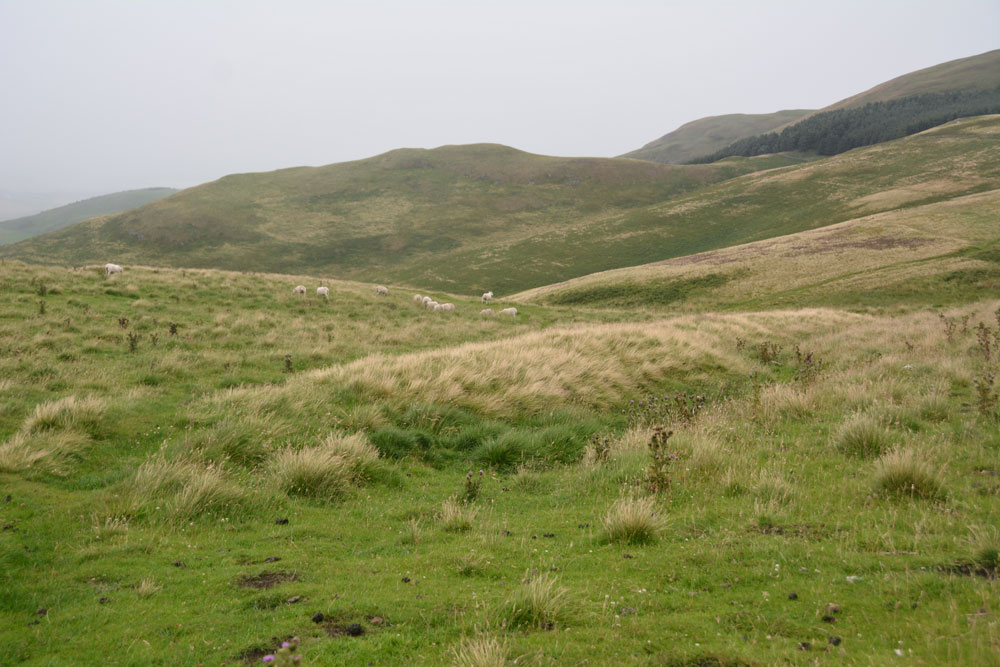
Stob Rig (Yetholm) submitted by Anne T on 7th Aug 2017. This is the eastern most of the banks with a slight ditch on its downhill side. The bank running parallel to it can be seen just on the horizon to the middle-left hand side of the photograph, delineated by the yellow grass growing on the bank.
(View photo, vote or add a comment)
Log Text: Stob Rig Earthworks: On the way up to the Stob Stones from the Pennine Way, there were two really obvious earthworks running in parallel towards the stones and we walked between them to reach the stones. I was keen to try and get out of the wind and the rain (almost impossible in this high, exposed spot) so didn't stop to photograph them.
On the way back down to re-join the Pennine Way, the earthworks were slightly less obvious. With the howling wind and the rain lashed sharply against my cheeks, I was tempted to put the camera safely in the rucksack, but having walked all this way up the hill, I wanted to document them.
In the end, I only managed to photograph the eastern most of the banks; the photos of the western-most had too many raindrops on the camera lens to be of any use.
Green Humbleton Hillfort
Trip No.37 Entry No.8 Date Added: 8th Aug 2017
Site Type: Hillfort
Country: Scotland (Scottish Borders)
Visited: Saw from a distance on 6th Aug 2017. My rating: Condition 3 Ambience 4 Access 3

Green Humbleton Hillfort submitted by NeilD on 6th Oct 2003. Green Humbleton-2
Northumberland
NT 846277
(View photo, vote or add a comment)
Log Text: Green Humbleton Hillfort: Having been virtually blown off the hillside at Green Humbleton Scooped Settlement on our way up the Pennine Way, we decided we’d visit the Stob Stones first and see if the wind died down on our way back. If the wind was bad on Stob Rig, then what would it be like on the top of this cone-shaped hill? It didn't, so reluctantly we decided to try on a warm, sunny day.
By the time we walked back down the Pennine Way/St Cuthbert’s Way, we were absolutely soaking wet, but at least in the valley below the wind had died down. Rather than the 6-8 cars in the parking area by Bowmont Water, there was only one camper van and our car. A lovely spot for some ‘wild camping’.
Ad Gefrin
Trip No.37 Entry No.9 Date Added: 28th Aug 2017
Site Type: Ancient Palace
Country: England (Northumberland)
Visited: Yes on 6th Aug 2017. My rating: Condition 1 Ambience 4 Access 5
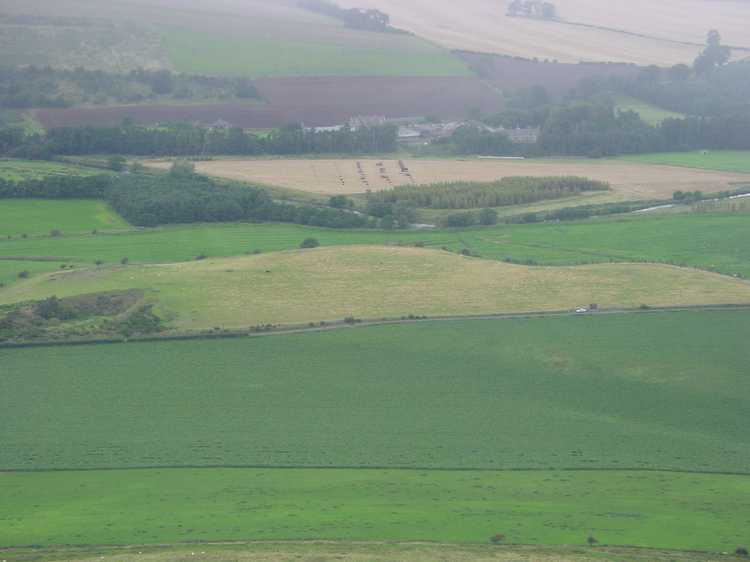
Ad Gefrin submitted by PaulH on 13th Mar 2003. Yeavering Bell hill fort
View of Ad Gefrin at NT926305
At the foot of Yeavering Bell is the site of probably the most impaces dating from the seventh century. The palace, Ad Gefrin, (the place of the goats) was one of the homes of King Edwin of Northumbria, whose name was given to another town - 'Edwin's Burgh', now known as Edinburgh.
It was at Ad Gefrin that St Paulinus baptised 3000 Northumbrians in 627 AD, just about twenty-five years prior to St Cuthbert's entry into Melrose Abbey.
(View photo, vote or add a comment)
Log Text: Ad Gefrin, Northumberland (near Yeavering): Trying to dry out from the walk to the Stob Stones, we decided to go back via Wooler and the A687 rather than back down the A68, passing Yeavering Bell on our way. Driving north, I was surprised to find we re-entered England from Scotland, back into Northumberland National Park. As we drove through Kirknewton, this ‘stone bus shelter’ and unusual gate posts caught my eye and we screeched to a halt.
I was amazed that we’d never heard of this site at all, and I read the interpretation board, then walked into the field to look at the other board. In front of me there was nothing but tall, yellow grass, with a faint darker green line where a narrow track ran along the edge of the field.
There was nothing on the interpretation board to tell us where about on the site we were. Seeing that the site spread across the road, I crossed and peered into the field. This, of course, now being England, I couldn’t just let myself into the field and wander around.
There being an excellent 4G signal here, I pulled up the Gefrin website and was really surprised to find this site described as the most evocative archaeological sites in Northumberland and also one of the most remarkable archaeological discoveries of the 20th century.
If I hadn’t been so wet and tired after a long day out, I’d have walked round the fields. As it was, we decided to return home, do some investigation and return to the site another day (adding to our ever growing list of ‘want to see’ sites).
Rockcliffe (Cumbria)
Trip No.38 Entry No.3 Date Added: 18th Aug 2017
Site Type: Ancient Cross
Country: England (Cumbria)
Visited: Yes on 17th Aug 2017. My rating: Condition 3 Ambience 4 Access 5

Rockcliffe (Cumbria) submitted by Anne T on 18th Aug 2017. First view of the Rockcliffe Cross from the iron gates by the mounting block. It sits to the right of the path leading to the south porch.
(View photo, vote or add a comment)
Log Text: The Rockcliffe Wheel-headed Cross, Cumbria: From the centre of Carlisle, we followed the signs heading north on the A7, out to the large Asda by the M6. Just before junction 44, a road north west into the industrial estate, clearly signposted to Rockcliffe.
This road leads straight into the village, with the church being on the south western corner of the village where the minor road turns right. There is room to park by the main iron gates to the church, next to the mounting block, in a small triangular piece of road.
Immediately inside the gates, the cross is straight in front of you, just to the right of the path leading to the south porch. Nearby is a modern grave marker in a smaller, but similar shape.
The church sits on a promontory, and as you walk down to the south porch a bend of the River Eden comes into view. On the north side of the church the land drops sharply down to Rockcliffe Beck with some graves on the terrace below. Even I was intrigued enough to walk the narrow path along the northern side of the church because I wanted to see the layout of the churchyard.
Sadly the church was locked, as I’d loved to have seen inside.
